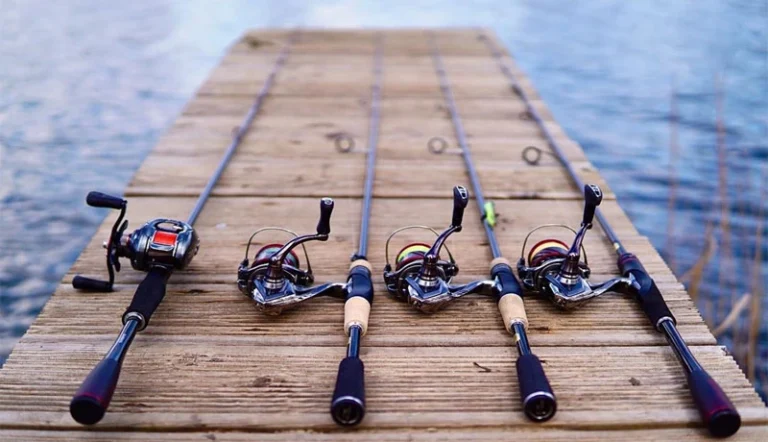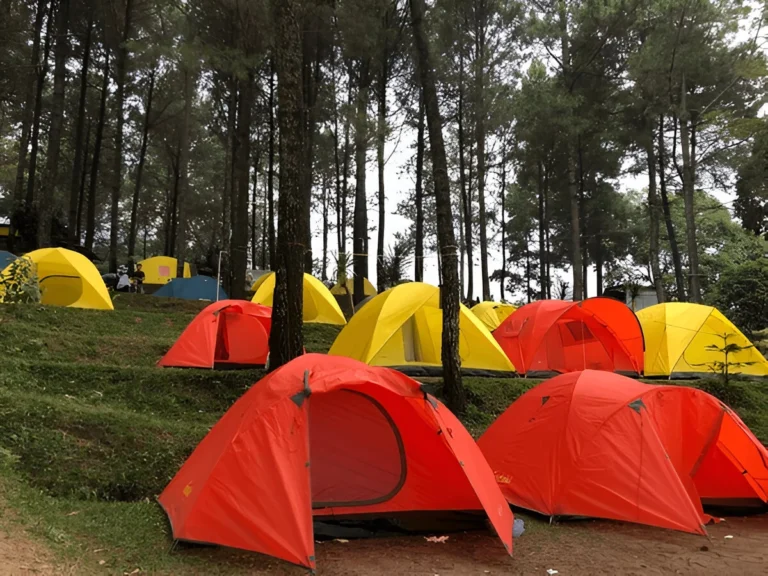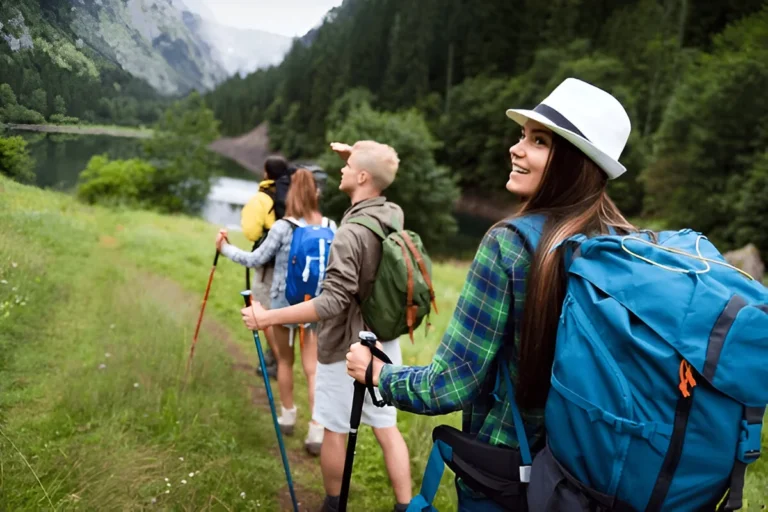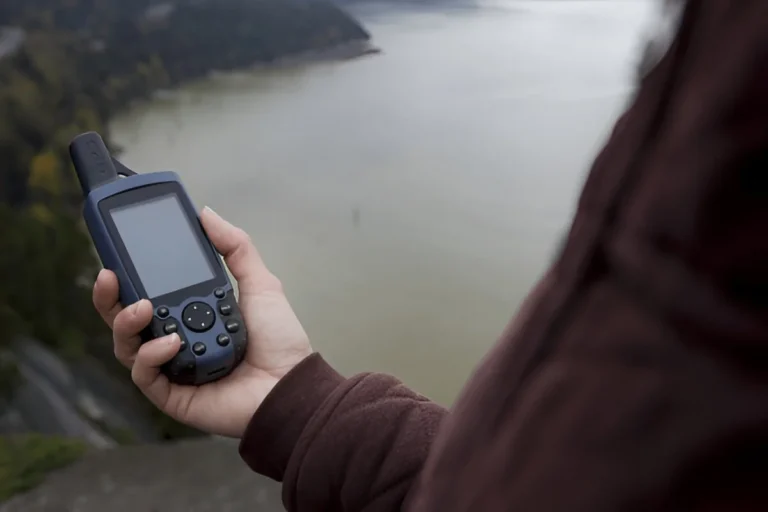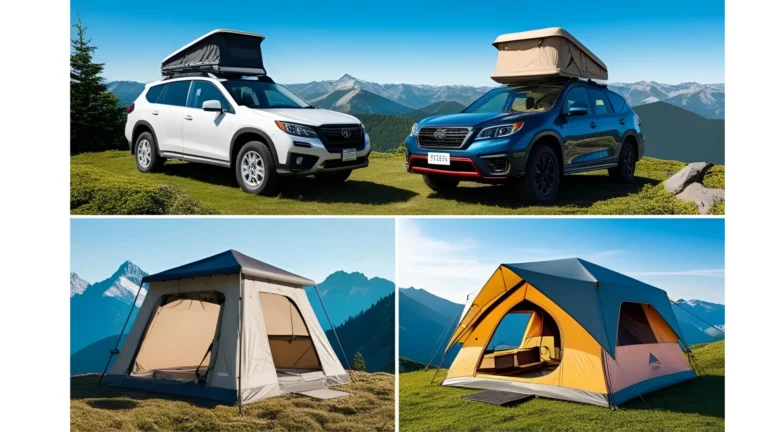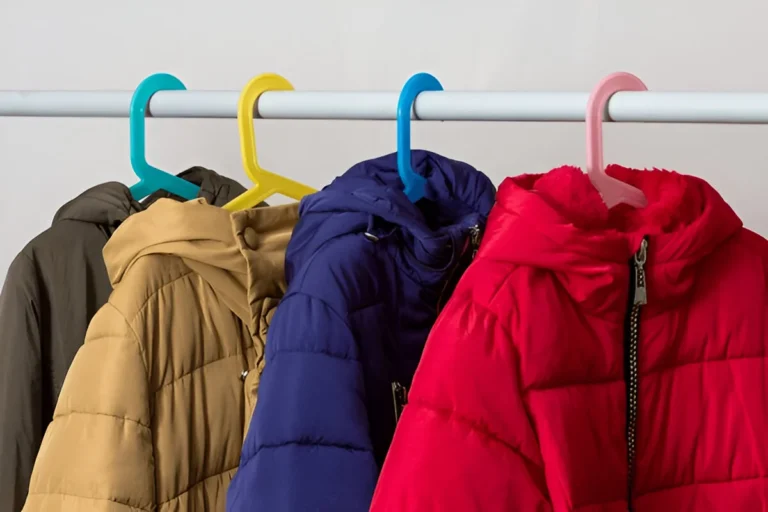Choosing the best backpacking sleeping bags in 2025 can make or break your outdoor adventure. The right sleeping bag keeps you warm, light on your feet, and comfortable, whether you are hiking rugged mountain trails, camping in forests, or embarking on multi-day backpacking trips. Modern sleeping bags are engineered with high-fill down insulation or advanced synthetic materials, offering excellent warmth-to-weight ratio, packability, and moisture resistance. Many feature draft collars, adjustable hoods, and internal stash pockets, enhancing both comfort and functionality. Our team can test the 50 to 60 Sleeping Bag Products by checking each one for its quality, price, and comfort, and we can pick these products for you. You can also check the review of the Best Hiking Daypacks, which our team has tested.
In this guide, we have reviewed the top-rated backpacking sleeping bags of 2025, tested in real outdoor conditions. We’ll cover premium ultralight options, budget-friendly picks, and specialized designs for cold weather, helping you find the perfect bag for your next adventure.
Top Best Backpacking Sleeping Bags Review
When choosing a backpacking sleeping bag, you should think about warmth, weight, comfort, packability, and how well it handles different weather conditions. We tested the top sleeping bags for all types of hikers, whether you are a casual camper or a long-distance thru-hiker. Our top choice is the Western Mountaineering MegaLite. It is lightweight, warm, and gives you extra room to move, making it ideal for most three-season adventures. If you want something more budget-friendly, the Kelty Cosmic Ultra 20 is a smart pick. It is affordable, durable, and performs well even in cooler temperatures.
For entry-level backpackers, the Amazon Basics 20°F Sleeping Bag is a simple, low-cost option that gets the job done. If you often camp in colder, high-altitude conditions, the Western Mountaineering UltraLite keeps you warmer without adding much bulk. The Kelty Cosmic 20 offers another affordable down option, great for those who want comfort without spending too much. For an all-around adult down sleeping bag, our pick provides excellent insulation, is easy to compress, and is perfect for weekend trips or longer treks.
1. Overall Best Backpacking Sleeping Bag – Western Mountaineering MegaLite
Specifications
- Temperature Rating: 30°F
- Weight: 1 lb 8 oz (24 oz)
- Insulation: 850+ fill-power goose down
- Shell: 12D nylon ripstop with DWR
- Lining: 15D nylon taffeta
- Shape: Wide mummy
- Zipper: Full-length #5 YKK with draft tube
- Pack Size: 6 x 12 inches

The Western Mountaineering MegaLite is our top pick for 2025, which is designed for backpackers who want lightweight gear with excellent warmth. It is known for its 30°F temperature rating; it is perfect for three-season hiking, handling cool spring nights and brisk fall mornings with ease. Unlike most mummy bags that feel restrictive, the MegaLite has a wider cut, giving your shoulders and hips extra space. This makes it ideal for side sleepers or anyone who moves around during the night. Despite its roomy design, it maintains a low weight of just 1 lb 8 oz, making it highly portable for long treks.
REASONS TO BUY
- ltralight yet warm
- Spacious cut for better comfort
- Premium, long-lasting materials
- Compresses small for easy packing
REASONS TO AVOID
- Higher price tag
- Not suitable for winter conditions
The bag uses premium 850+ fill goose down, which is light, compressible, and long-lasting. Paired with a 12D nylon ripstop shell and 15D taffeta lining, it feels soft and comfortable while staying durable in rugged conditions. Its DWR finish helps repel light moisture, keeping you dry in damp environments. For convenience, it includes a full-length YKK zipper with an insulated draft tube, allowing you to ventilate in warm weather or fully zip up in cooler conditions. When packed, it compresses to 6 x 12 inches, saving valuable space in your backpack.
2. Best Budget Backpacking Sleeping Bag – Kelty Cosmic Ultra 20
Specifications
- Temperature Rating: 20F
- Weight: 2 lb 6 oz (38 oz)
- Insulation: 800-fill DriDown (water-resistant down)
- Shell: 20D nylon
- Shape: Mummy
- Zipper: Full-length YKK with anti-snag design
- Pack Size: 8 x 13 inches

If you are looking for a budget-friendly sleeping bag that still delivers great warmth and comfort, the Kelty Cosmic Ultra 20 is our top affordable pick for 2025. This bag is designed for three-season backpacking, offering a 20°F temperature rating, making it warmer than many entry-level models. The Cosmic Ultra uses 800-fill DriDown insulation, which is treated to resist moisture and retain loft even when damp, perfect for unpredictable weather on the trail. Despite its budget-friendly price, it includes features usually found in premium bags, such as a draft collar, insulated hood, and an anti-snag YKK zipper.
REASONS TO BUY
- Affordable with solid warmth
- Moisture-resistant down insulation
- Comfortable design with roomy footbox
- Good durability for frequent use
REASONS TO AVOID
- Heavier and bulkier than ultralight models
Weighing around 2 lb 6 oz, it is not as light as ultralight models, but it is still manageable for weekend trips and multi-day hikes. The 20D nylon shell and soft liner provide durability and comfort, while the bag compresses reasonably well into its stuff sack. Its spacious footbox gives you room to move your feet, and the overall design feels comfortable for both back and side sleepers. With its balanced warmth, durable construction, and affordable price, the Kelty Cosmic Ultra 20 is a great choice for beginners or budget-conscious backpackers who want reliable performance without spending too much.
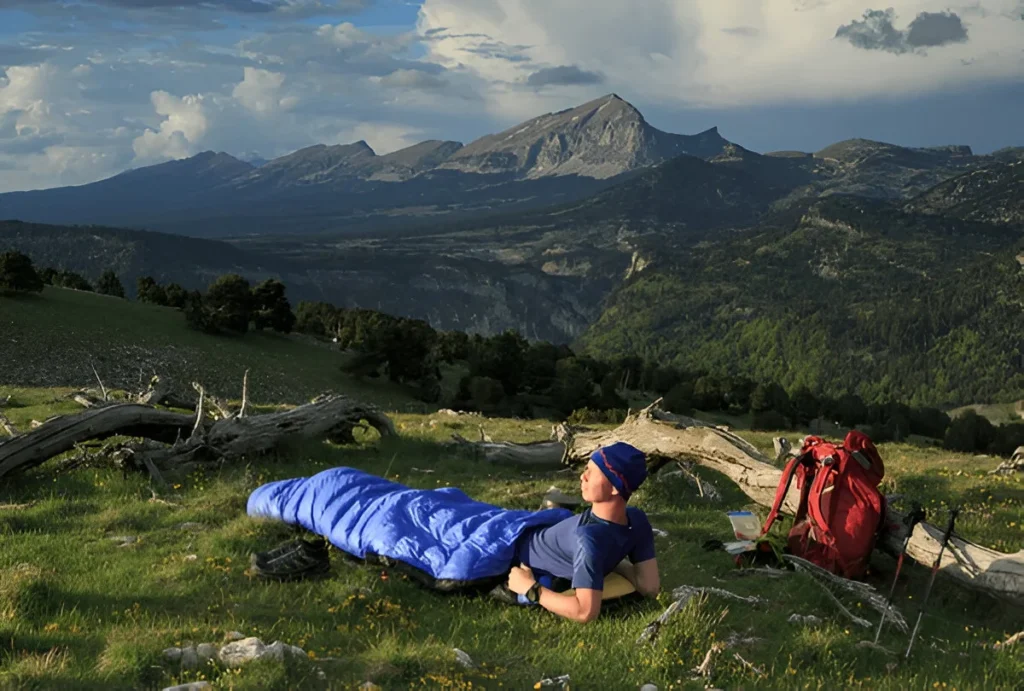
3. Amazon Basics 20°F
Specifications
- Temperature Rating: 20°F
- Weight: 3.5 lbs (56 oz)
- Insulation: Synthetic polyester fill
- Shell: 100% polyester
- Shape: Semi-rectangular mummy
- Zipper: Full-length with draft tube
- Pack Size: 10 x 17 inches
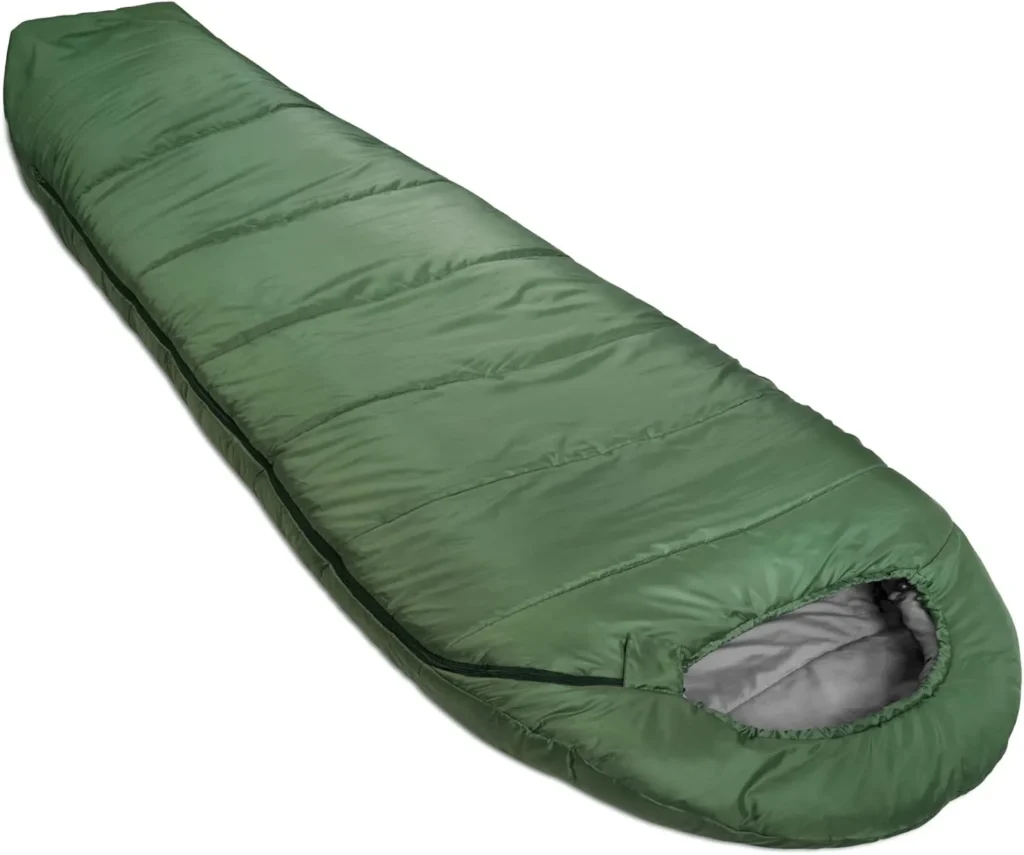
For those who need a simple and affordable sleeping bag for occasional backpacking or camping trips, the Amazon Basics 20°F Sleeping Bag is a great entry-level option in 2025. This is designed for three-season outdoor use. It provides reliable warmth down to 20°F, making it suitable for spring, summer, and fall adventures. This bag features synthetic insulation, which performs well in damp conditions and dries faster than down. It is built with a durable polyester shell and soft lining, ensuring comfort while keeping costs low. Weighing about 3.5 lbs, it’s heavier than ultralight bags but still manageable for shorter backpacking trips or car camping.
REASONS TO BUY
- Very affordable price
- Performs well in wet conditions
- Comfortable, roomy design
- Durable and beginner-friendly
REASONS TO AVOID
- Heavier than down alternatives
- Bulkier pack size
The design includes a full-length zipper, adjustable drawstring hood, and draft tube, helping to seal in heat during cooler nights. Its rectangular-to-mummy shape offers more room around the shoulders and legs, making it comfortable for various sleeping positions. While it does not compress as small as premium models, it is a budget-friendly choice for beginners, casual campers, or anyone who needs a reliable sleeping bag without investing in high-end gear.
4. Best for Colder 3-Season Conditions – Western Mountaineering UltraLite
Specifications
- Temperature Rating: 20°F
- Weight: 1 lb 13 oz (29 oz)
- Insulation: 850+ fill-power goose down
- Shell: 12D ExtremeLite nylon with DWR
- Lining: 15D nylon taffeta
- Shape: Mummy
- Zipper: Full-length #5 YKK with draft tube
- Pack Size: 7 x 13 inches
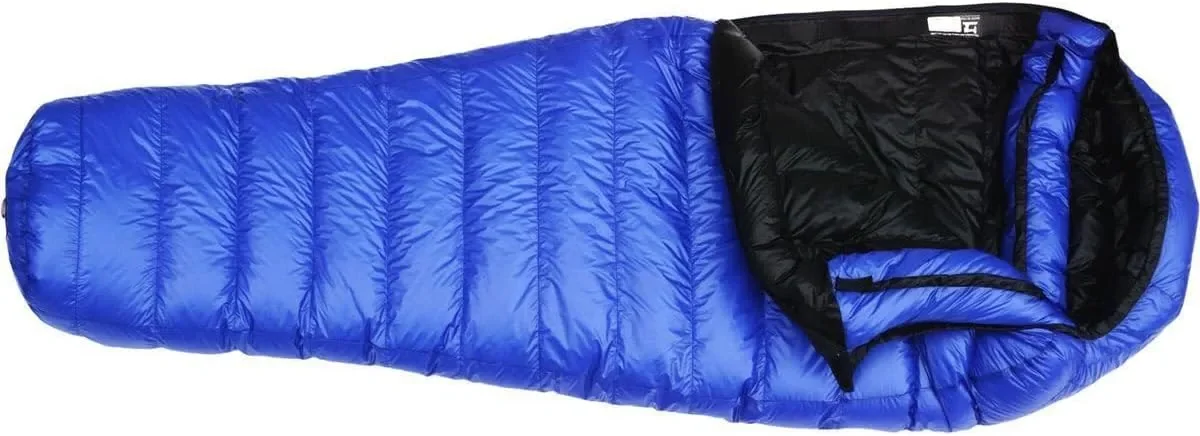
If you are planning to backpack in colder 3-season conditions or camp in higher elevations, the Western Mountaineering UltraLite is an outstanding choice for 2025. This premium sleeping bag is rated for 20°F, offering extra warmth compared to the MegaLite, while still being lightweight and highly compressible. It features 850+ fill-power goose down insulation, providing exceptional loft and comfort without adding bulk. Weighing only 1 lb 13 oz, it is surprisingly light for the warmth it delivers. The mummy-style design wraps snugly around your body to retain heat, while the adjustable hood and insulated draft collar help block cold air during freezing nights.
REASONS TO BUY
- Excellent warmth for cold 3-season conditions
- Lightweight and highly compressible
- Premium down and shell materials
- Draft collar and hood provide great heat retention
REASONS TO AVOID
- Expensive compared to mid-range options
- Narrower fit
The UltraLite is constructed with a high-quality 12D nylon shell and a soft 15D nylon taffeta lining, giving it durability and a plush feel against the skin. Its full-length YKK zipper with a draft tube allows for temperature regulation, making it versatile for different conditions. Thanks to its compact pack size, this bag is perfect for multi-day treks, alpine backpacking, or early spring and late fall adventures where temperatures drop below freezing. While it is on the expensive side, its longevity, warmth, and ultralight design make it a worthwhile investment for serious backpackers.
5. Kelty Cosmic 20
Specifications
- Temperature Rating: 20°F
- Weight: 2 lb 9 oz (41 oz)
- Insulation: 550-fill duck down
- Shell: 20D nylon
- Liner: Soft polyester
- Shape: Mummy
- Zipper: Full-length with anti-snag design
- Pack Size: 9 x 16 inches
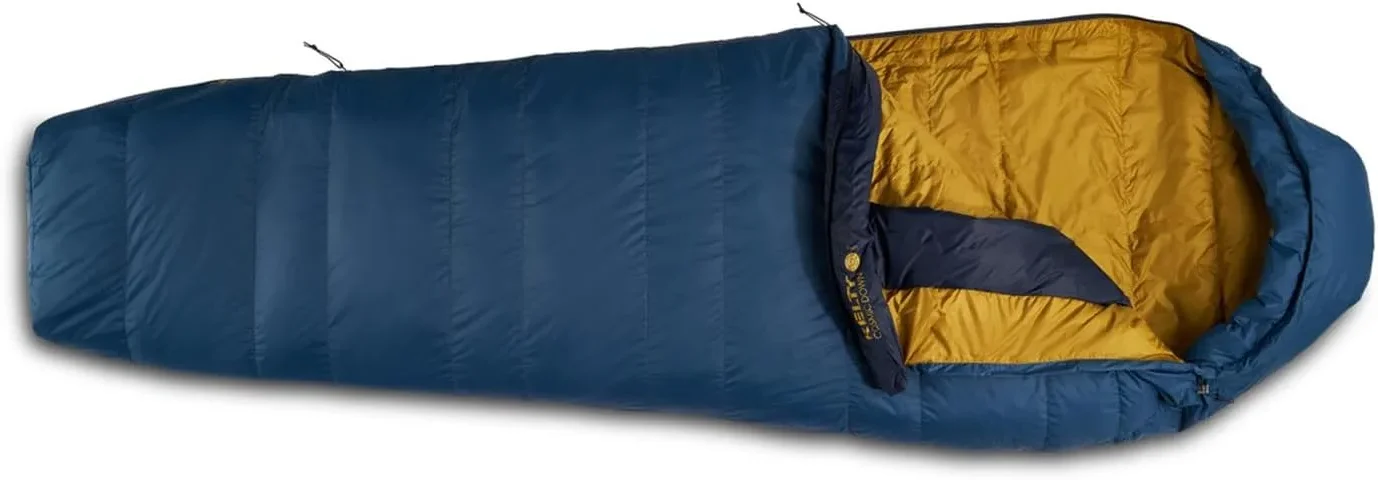
The Kelty Cosmic 20 is one of the most popular budget-friendly down sleeping bags for backpackers in 2025. Designed for three-season camping, it offers solid warmth and comfort at an accessible price, making it a top choice for beginners and weekend adventurers. This bag uses 550-fill duck down insulation, which provides decent loft and warmth while keeping costs low. Rated for 20°F, it can handle cool spring nights and early fall camping trips with ease. Weighing about 2 lb 9 oz, it is heavier than ultralight models but still suitable for most backpacking trips.
REASONS TO BUY
- Affordable down sleeping bag
- Comfortable and slightly roomy fit
- Durable materials for long-term use
- Good warmth for casual three-season camping
REASONS TO AVOID
- Heavier and bulkier than ultralight models
- Less compressible
The durable 20D nylon shell holds up well to repeated outdoor use, while the soft polyester liner feels comfortable against the skin. The mummy shape is slightly roomier than many high-end models, making it a good option for people who want extra sleeping space. It features a full-length zipper for easy entry and ventilation, plus a drawstring hood to seal in warmth on colder nights. While it’s bulkier and less compressible than premium bags, the Cosmic 20 is a great value option for those who want down insulation without breaking the bank.
6. Down Sleeping Bag for Adults
Specifications
- Temperature Rating: 20°F
- Weight: 2 lb 8 oz (40 oz)
- Insulation: 650-fill down insulation
- Shell: Water-resistant ripstop nylon
- Liner: Soft polyester lining
- Shape: Mummy with hood
- Zipper: Full-length, two-way
- Pack Size: 8 x 14 inches (compressed)
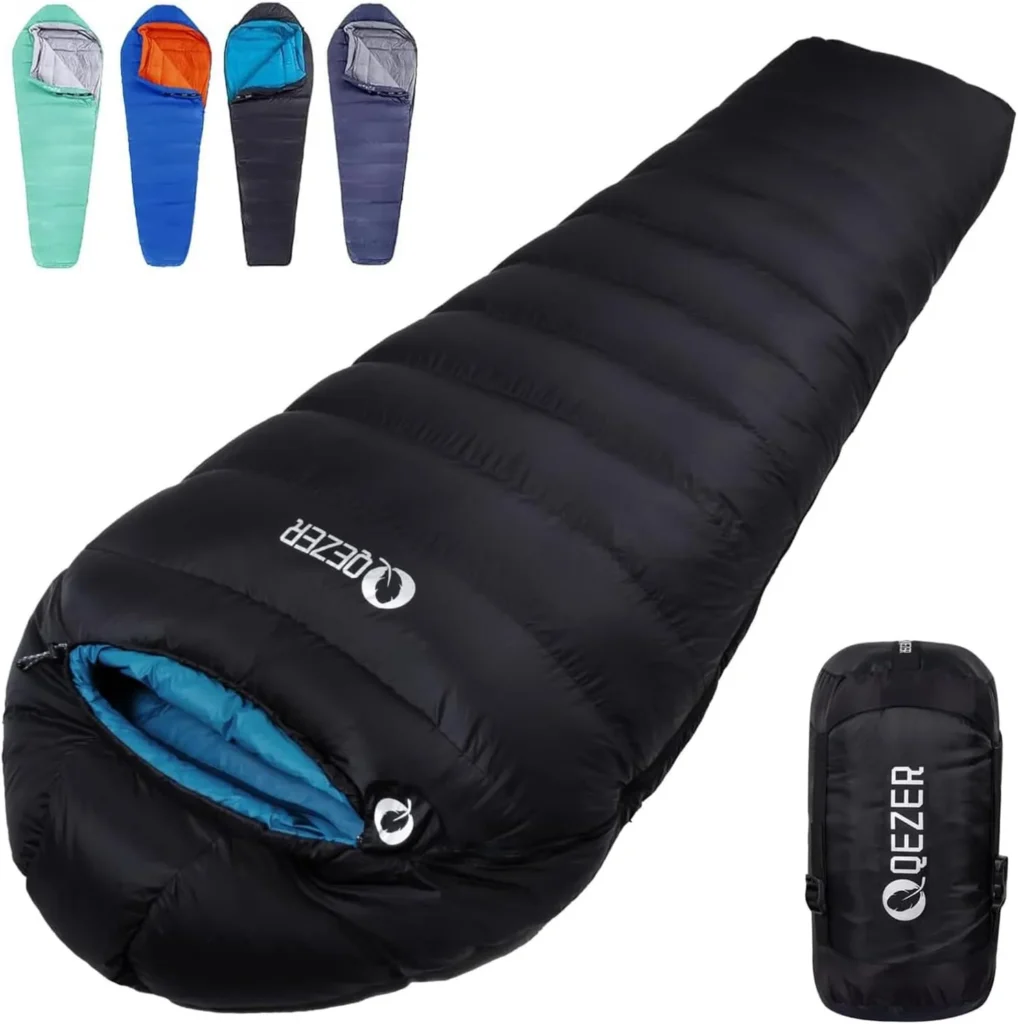
For hikers and campers looking for an all-around down sleeping bag that balances affordability, warmth, and packability, the Down Sleeping Bag for Adults is a solid choice in 2025. Designed for three-season use, it’s ideal for weekend backpacking trips, car camping, and multi-day hikes in moderate to cool conditions. This sleeping bag is filled with high-quality down insulation, providing better warmth-to-weight performance than most synthetic options. It has a temperature rating of 20°F, making it suitable for spring through early winter camping in mild to cold environments. Weighing around 2 lb 8 oz, it’s light enough for backpacking while still being durable and comfortable.
REASONS TO BUY
- Affordable down sleeping bag
- Good warmth and lightweight design
- Compressible for easy backpacking
- Water-resistant shell for damp conditions
REASONS TO AVOID
- Lower fill power than premium bags
- Bulkier than ultralight options
The water-resistant shell and soft interior lining make it cozy to sleep in, while its mummy-style design with a hood and draft collar helps trap body heat effectively. A two-way zipper allows for ventilation in warmer conditions or zipping together with another bag for a double sleeping system. Its compressible design makes it easy to pack into a backpack, and the included compression sack reduces its size further. Perfect for beginner to intermediate campers, this bag offers a good balance of price, comfort, and performance, making it a practical choice for most outdoor enthusiasts.
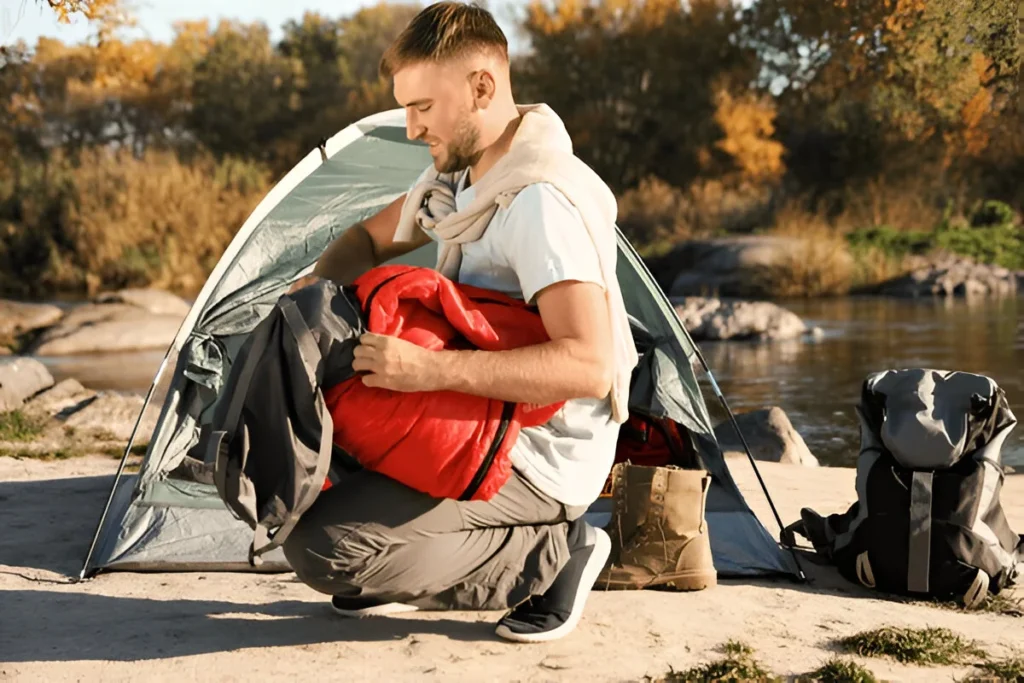
How We Tested
At Outdoor Searcher, we believe that real-world testing is the only way to accurately evaluate outdoor gear. For this guide, our expert team spent over 300 hours field-testing sleeping bags across different terrains, including mountains, forests, and wet environments. Each bag was tested for thermal efficiency, comfort, and practicality, with real backpacking trips to simulate actual usage. This hands-on approach ensures that every recommendation is based on authentic performance, not just manufacturer specifications.
How We Rate Products
Overall
The overall rating is a combined performance score, taking into account warmth, comfort, weight, durability, and extra features. This holistic view allows you to quickly understand which sleeping bags provide the most balanced performance. A high overall score means the bag performs consistently well in multiple categories, making it a versatile choice for a wide range of backpacking conditions.
Comfort
A good night’s sleep can make or break a backpacking trip, which is why comfort plays a critical role in our evaluation. We assess fabric softness, ergonomic design, and interior space, ensuring that the bag is suitable for different body types and sleeping positions. Special attention is given to zippers for easy entry/exit, non-restrictive cuts for side sleepers, and additional touches like draft collars and padded hoods, all contributing to overall nighttime comfort.

Weight
In backpacking, every ounce counts. A sleeping bag’s weight directly affects your mobility, energy use, and overall pack load. We precisely weigh each product and evaluate its warmth-to-weight ratio, ensuring that it provides adequate insulation without unnecessary bulk. Ultralight models score higher here, making them ideal for thru-hikers and minimalist backpackers who prioritize speed and efficiency on long trails.
Features
Features can make a significant difference in practicality and usability during real outdoor adventures. We look for functional enhancements like adjustable hoods that improve warmth, draft collars and tubes that prevent heat loss, dual zippers for ventilation and compatibility with other bags, and internal stash pockets for keeping essentials close. Bags that strike the right balance between useful features and minimal added weight score highest in this category.
Water Resistance
Nature is unpredictable, and a wet sleeping bag can be dangerous in cold conditions. We test each bag’s moisture resistance, focusing on shell fabric coatings (like DWR) and how well the insulation retains warmth when damp. Down sleeping bags treated with hydrophobic coatings and synthetic bags that dry quickly perform best here, ensuring you stay warm and dry even during rain or condensation-heavy nights.
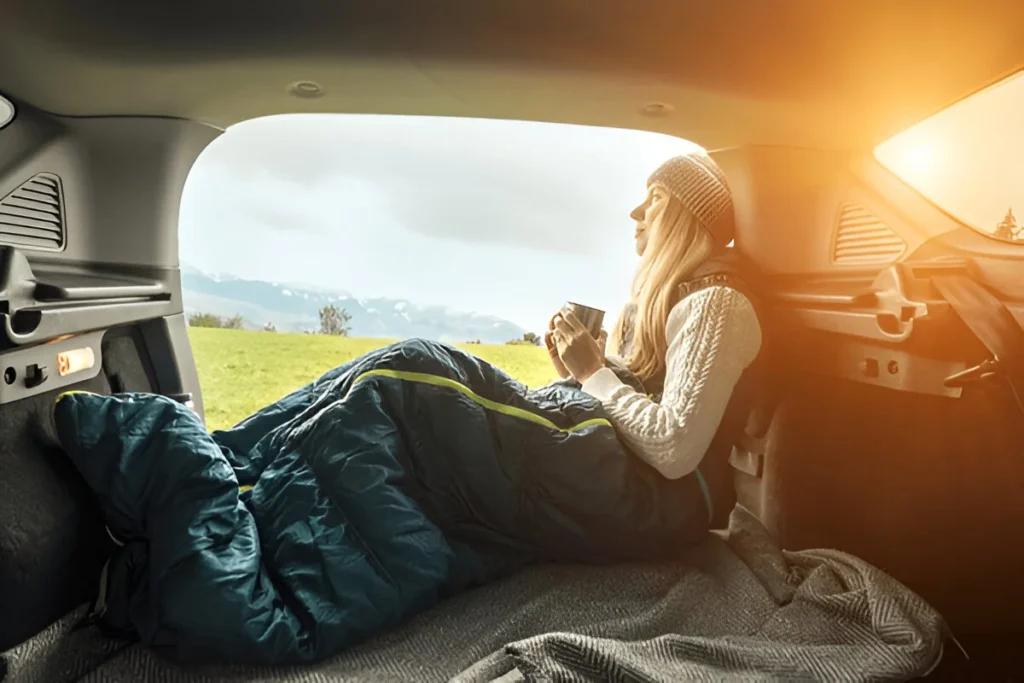
Durability
Durability determines how well your investment will hold up over the years of use. We inspect the quality of materials, including ripstop nylon shells, reinforced stitching, zipper robustness, and seam strength. Sleeping bags that maintain their loft and integrity after repeated packing, compression, and exposure to rough terrains score highest, giving you long-term reliability for extended backpacking adventures.
Sustainability
Environmental responsibility is becoming increasingly important in outdoor gear. We value brands that prioritize sustainability, such as using recycled fabrics, responsibly sourced down (RDS-certified), and eco-friendly production processes. Sleeping bags that combine high performance with minimal environmental impact are highlighted in this category, ensuring you can explore nature while also protecting it for future adventurers.

Analysis & Results
VALUE
The value score indicates how much performance and quality you get relative to the sleeping bag’s price. A high-value sleeping bag balances warmth, comfort, and durability while remaining budget-friendly. We consider factors such as insulation efficiency, material quality, longevity, and included features when determining value. This rating is particularly useful for beginner backpackers and cost-conscious adventurers who want reliable gear without spending top dollar.
WARMTH
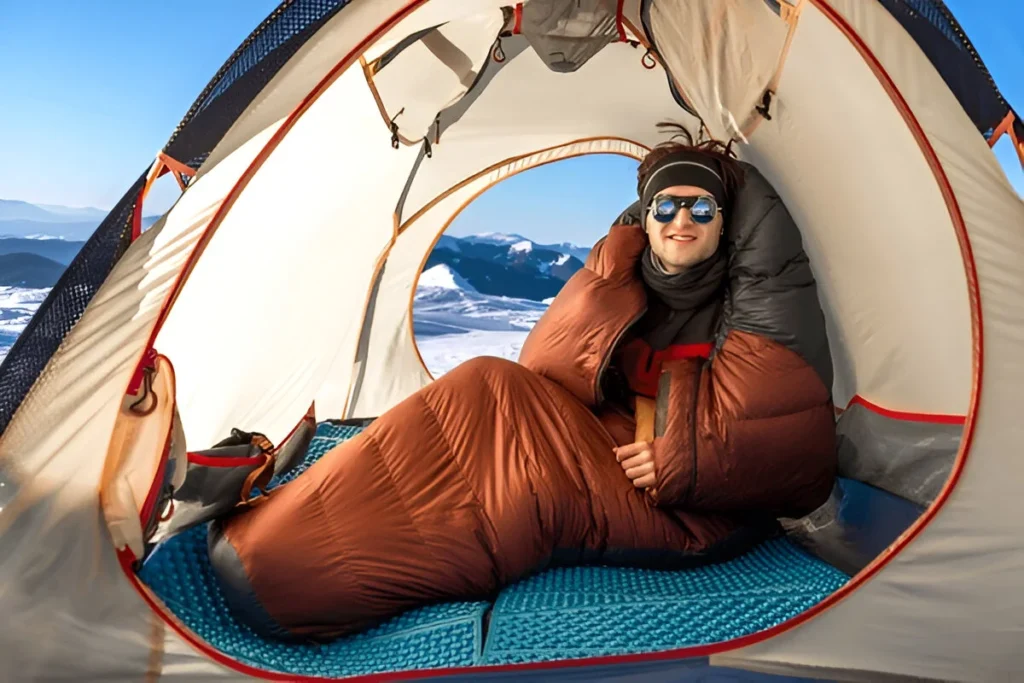
Staying warm is essential for safety and comfort in the backcountry. Our warmth rating evaluates a sleeping bag’s temperature performance, ensuring it aligns with its advertised rating. We assess how well the bag’s insulation (down or synthetic) traps body heat, how efficiently it minimizes cold spots, and whether it includes draft collars, hoods, and zipper baffles to prevent heat loss. Unlike lab-based ratings, our tests focus on real environmental conditions, giving you a practical understanding of its thermal performance.
WEIGHT & PACKABILITY
For backpackers, every ounce and cubic inch in your pack matters. We carefully measure both the total weight and compressed pack size of each sleeping bag to determine how well it fits into a backpacking setup. Bags that are ultralight and highly compressible receive top scores, making them ideal for long-distance hikers, thru-hikers, and minimalist travelers. We also consider how easily the bag can be compressed into its sack and how much space it takes in a standard hiking backpack.
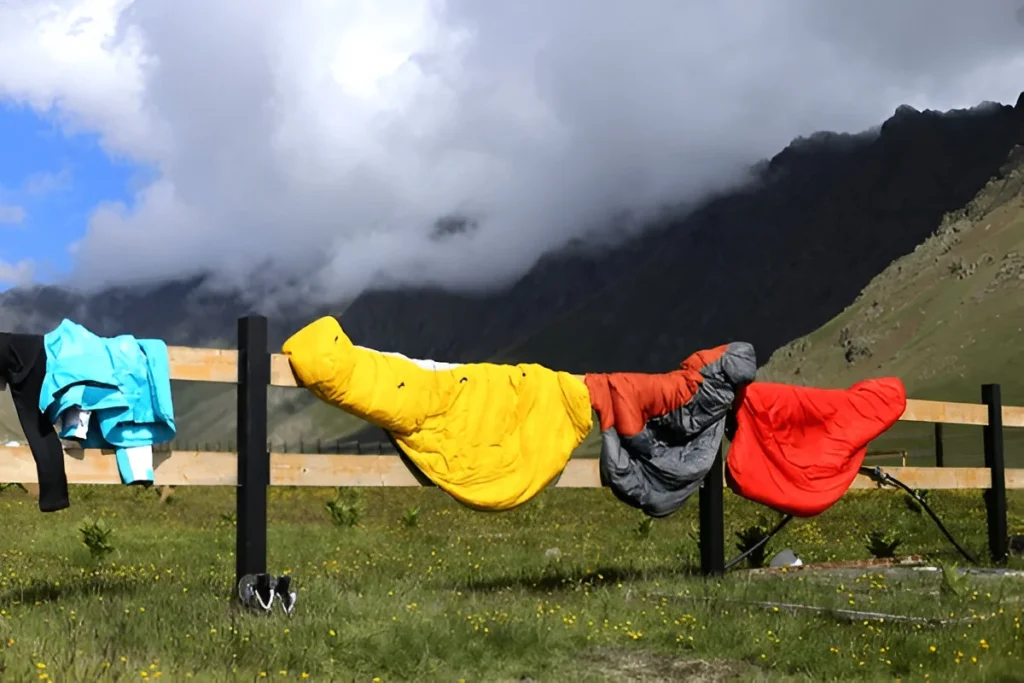
How Should We Size a Sleeping Bag?
Choosing the right size is crucial for comfort and efficiency. A sleeping bag that’s too large can leave cold air pockets, while one that’s too tight restricts movement. We recommend:
Length: Select a bag that’s 2–3 inches longer than your height for comfort.
Width: Side sleepers should look for wider mummy designs.
Shape: Mummy bags offer the best warmth, while semi-rectangular bags provide extra space.
Gender-Specific Options: Women’s sleeping bags often have extra insulation in key areas like the feet and torso.
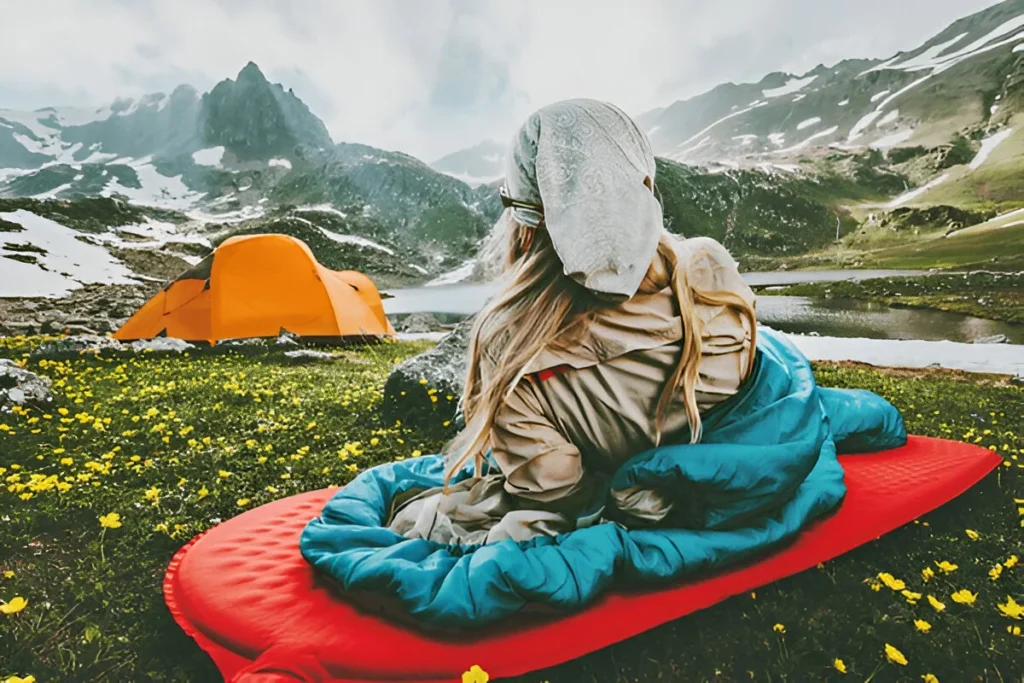
Why Trust Outdoor Searcher
At Outdoor Searcher, we understand that choosing the right gear can mean the difference between a successful, comfortable adventure and a challenging, sleepless trip. That is why we go beyond typical online reviews; we provide authentic, field-tested recommendations that you can truly rely on.
With over a decade of hands-on experience, our dedicated team of outdoor enthusiasts has spent thousands of hours hiking, camping, and backpacking in some of the world’s most rugged terrains. Unlike many sites that simply compile manufacturer specs or promotional claims, every product we recommend is tested in real outdoor conditions. From high-altitude alpine treks to humid forest trails, we push each sleeping bag to its limits to evaluate its true performance, durability, and comfort.

John Smith – Review Editor
John Smith is the Lead Review Editor at Outdoor Searcher, bringing over 12 years of backpacking and outdoor gear testing experience. Having completed multiple thru-hikes across North America and Europe, John has faced challenging terrains and extreme weather, giving him a deep understanding of what makes gear truly reliable. His expertise ensures that every sleeping bag we recommend has been thoroughly tested in real-world conditions, providing unbiased, practical insights to help fellow adventurers choose the best equipment for their journeys.
Conclusion
The right backpacking sleeping bag can completely transform your outdoor experience by keeping you warm, lightweight, and well-rested throughout your journey. A high-quality sleeping bag is more than just gear; it is a key factor in ensuring comfort, safety, and quality sleep, allowing you to wake up refreshed and ready to conquer the trail ahead. Our expert tested recommendations provide options for every type of adventurer, whether you are a thru-hiker seeking ultralight performance, a weekend camper looking for a budget-friendly yet reliable option, or an alpine explorer in need of extra insulation for cold-weather conditions.
By testing and analyzing each sleeping bag for warmth-to-weight efficiency, durability, comfort, and real-world performance, we’ve selected the top choices for 2025 to help you make a confident, informed purchase. With the right sleeping bag in your pack, you can enjoy better rest, improved trail stamina, and a safer, more enjoyable backpacking experience, no matter where your next adventure takes you.
FAQs
How do I choose the best backpacking sleeping bag for my trip?
When selecting a sleeping bag, focus on temperature rating, ensuring it matches the lowest nighttime temperature of your trip. Consider weight and packability for easier carrying on long hikes, and check its weather resistance to handle damp or cold conditions. The right size and shape (mummy, rectangular) also impact comfort and warmth efficiency.
What is the difference between down and synthetic sleeping bags?
Down sleeping bags are made with goose or duck feathers, offering a superior warmth-to-weight ratio and compressibility, making them ideal for ultralight backpackers. However, they lose insulation when wet. Synthetic bags use polyester fibers that retain warmth even when damp and dry faster, making them better for humid or rainy conditions, though they are bulkier.
Can I use one sleeping bag year-round?
While most 3-season sleeping bags work well for spring, summer, and fall, they may not provide adequate warmth for harsh winter conditions. For year-round use, consider a bag with a lower temperature rating or combine it with a sleeping quilt or liner for added insulation in winter.
How do I properly clean and store a down sleeping bag?
Use a down-safe detergent and wash the bag gently, preferably in a front-loading washing machine. Tumble dry on low heat with dryer balls to restore loft. When storing, keep it uncompressed in a large breathable sack, as long-term compression damages insulation and reduces warmth efficiency.
What temperature rating should I look for in a backpacking sleeping bag?
Choose a sleeping bag with a temperature rating 10 15°F lower than the coldest temperature you expect to encounter. This provides a safety margin in case of unexpected weather drops. For typical 3-season backpacking, a 20°F bag is often suitable for most environments.
How important is weight and pack size when choosing a sleeping bag?
Weight and pack size are crucial for long-distance or multi-day backpacking trips where every ounce matters. A lightweight, compressible sleeping bag saves space and reduces fatigue during hikes. Ultralight down bags often provide the best warmth-to-weight ratio, while synthetic bags may be bulkier but still manageable for shorter trips.

